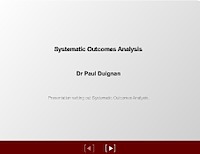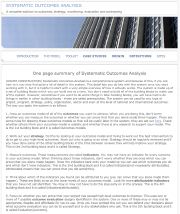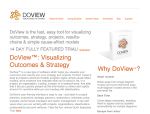Systematic Outcomes Analysis provides a complete solution to outcomes, strategic planning, monitoring, evaluation, economic evaluation, evidence-based practice and contracting. If you want to start with a simpler, more user-friendly version of Systematic Outcomes Analysis implemented using DoView outcomes software start with Easy Outcomes.
What can it do for you?
• give you a fully integrated approach to solving many of the organizational or sector-collaboration issues you face
• avoid duplication of effort by helping you develop a standard set of building blocks which then work together
• avoid a piecemeal approach to outcomes, strategic planning, monitoring, evaluation, economic evaluation, contracting etc.
• provide a sophisticated and credible solution to today's problem of showing that you are achieving your outcomes in situations where this is difficult to prove absolutely
• prove to your stakeholders that you are on top of these issues.
What is Systematic Outcomes Analysis?
Systematic Outcomes Analysis* integrates many aspects of organizational life which up until now have not always been sufficiently connected. It will help you:
• define, think about and justify your outcomes
• think about your strategic planning steps and priorities
• monitor whether your outcomes and lower level steps are being reached
• determine (and justify to stakeholders) what kind of high level outcome evaluation is possible
• determine what should be the focus of other types of evaluation (implementation, formative and process)
• determine what type of economic evaluation analysis you should do
• determine your overall monitoring and evaluation scheme
• identity exactly what you should be accountable for and (if you are in a 'funder' and 'doer' situation) what type of contracting arrangements are appropriate.
Where has Systematic Outcomes Analysis been used?
Aspects of Systematic Outcomes analysis have been used:
• in a range of local, national and international settings where outcomes are being specified, evaluated, monitored or reported on
• to develop outcomes, evaluation and monitoring plans in a number of public sector settings, including organizations, regulatory frameworks, policies and programs
• in large and small organizations
• as a framework for planning evaluation of the IMFs national and multilateral economic surveillance activity*.
Is Systematic Outcomes Analysis Complex?
Systematic outcomes analysis is comprehensive rather than complex. If you work with organizations, sectors, joint venture collaborations or programs, you will at some stage in your career have to deal with most, if not all of the elements within Systematic Outcomes Analysis. You can either deal with these in a one-off piecemeal fashion or deal with them systematically within a single overall framework. You don't need to do all the steps in Systematic Outcomes Analysis all at once. You can quietly build you system over time. However, as you go you can be sure that different parts of your system, because of the way they've been designed, will work together in the future. More on this point here.
Is Systematic Outcomes Analysis a generally applicable system?
Systematic Outcomes Analysis has been designed to be a general approach which can be used in any outcomes area to develop a comprehensive approach to outcomes, strategy, monitoring, evaluation etc. It has also been designed to accommodate the contrasting paradigms which some people hold and which influence how they think about outcomes. For more on how Systematic Outcomes Analysis provides a common platform for those holding different paradigms see here.
Introduction to the system
There is a very simple one page written introduction here and a more detailed Flash presentation here.
[V1.1.2]
* Systematic Outcomes Analysis has in the past been known as: the Research, Evaluation, Monitoring and Outcome Logic approach (REMLogic); Outcomes Is It Working Analysis; and the OIIWA approach. These are all the same approach in earlier stages of development.



